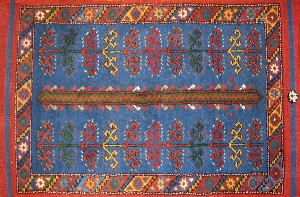A Manifestation of Color
by Robin Smalley
The cochineal insect (Dactylopius coccus Costa) is a parasite that lives on cacti (Opuntia ficus indica, called tuna in Peru) in the arid highlands of southern Peru. This insect grows on the natural cactus scrub throughout the sierra in the department of Ayacucho and has been cultivated by farmers for use as a natural colorant in textiles since the 1580s. I first learned about cochineal while participating in a natural dye course at The Evergreen State College, in Olympia, WA. As we learned about the origins of cutch, indigo, logwood, madder, osage, and cochineal, and experimented with their respective dye processes, I became fascinated by the cultural, social and ecological aspects of cochineal use as a natural dye.
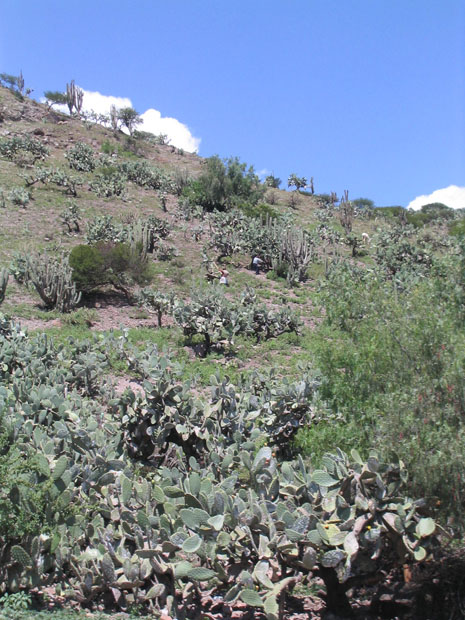
Photograph Copyright by Robin Smalley
I wondered about the living insect, as it grew on cacti in arid regions of Mexico and Peru. As I marveled at the intensity of color produced by the drying and crushing of these diminutive insects, I pondered the quantity and quality of cochineal needed to procure a regular source of dyestuff. Additionally, I wondered about the individuals who harvest and/or cultivate this insect. Who collects cochineal? Where? How often? What are the harvest methods? What happens after the insect is collected? These questions resonated within, and my inquisitiveness about cochineal evolved gradually, as the insect itself does, maturing and increasing in carminic acid, the chemical constituent responsible for its color.
After several seasons of reading about cochineal as a subject of intrigue, I decided to pursue this interest academically and researched cochineal through independent study at Evergreen during 2006-2007. I developed a yearlong study of the ethnoaesthetics of cochineal, investigating the ecological, cultural and economic domains of this natural resource. This objective then inspired my recent three-month study in Huamanga, Ayacucho, Peru, funded by an international study abroad scholarship, through which I explored current methods of cochineal cultivation, production and commercialization in southern Peru.
I arrived in Huamanga, commonly referred to as Ayacucho, and began to speak with people there, inquiring as to where I would find cochineal vendors. Answers were vague: 'near the market,' people told me, but I was not able to locate cochineal at the central market. Then, as I walked through the older barrios (neighborhoods) of the city, I began to find cochineal-infested cacti populating yards and empty lots. As I spoke with individuals in Spanish, explaining my interest in learning about cochineal cultivation, I began to understand that I would need to visit the campo (countryside) and converse in indigenous Quechua with the mamachas (peasant women). Realizing that these indigenous campesinos (farmers) are the peoples who live with and know the land, I began to study Quechua, in order to respectfully communicate with people in Ayacucho, and learn the story of cochineal.
As I worked with a self-educated teacher, a native Quechua speaker, who also spoke Spanish and some English, I began to explore the phonetics and grammar of runasimi, the language of the people. Simultaneously, I pursued institutional and local research regarding cochineal production. Fortuitously, I met entomologist and cochineal expert Víctor Flores Flores at the International Festival of Tuna, Cochineal and Native Plants in Ayacucho. Two weeks later, I accompanied Señor Flores on a visit to a nearby campesino community, as he monitored the health and disease infestation of cacti. There he introduced me to the Sergio Perez family, an established family in the community who harvest and sell cochineal to supplement their income.
After my initial visit, I returned to the community frequently, visiting with the family on a regular basis and interviewing household head Sergio regarding cochineal cultivation methods. Cochineal collection is a labor-intensive process that transitions with the seasons. In Ayacucho, the main harvest of cochineal begins around April 15, after the rainy season has passed. Rain threatens both the viability and quality of the insect harvested for dye; strong rains can lower the insect's carminic acid content (CAC), as well as physically displace cochineal from their cactus hosts. Cochineal harvested during the rainy season generally does not offer the same color quality as that from insects collected at mature size and/or CAC. Therefore, vendors pay lower prices for cochineal of this season, and consequently, campesinos earn less for their efforts.
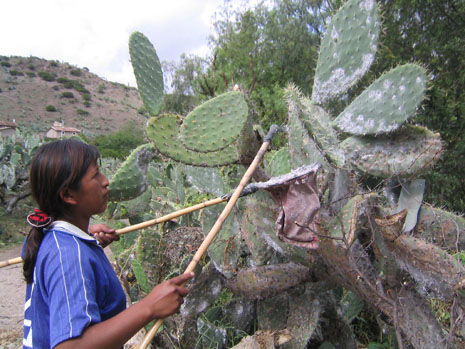
Photograph Copyright by Robin Smalley
To collect cochineal, campesinos use handmade tools called isupu and asa in Quechua. Farmers fashion these harvest tools from carrizo wood, formed into long (five-foot), slender poles. The isupu utilizes several coarse bristles, made from either nylon or animal whiskers, and serves to brush insects off of the cactus. In turn, the asa is a cloth or mesh netting that receives the cochineal falling from the plant. Farmers hold the isupu and asa in hand, with arms extended, and work tirelessly, moving from cactus pad to cactus pad, plant to plant, in order to fill their daily quotas. These self-selected amounts generally pertain to the campesino's availablity to harvest, and/or the desired weight of cochineal bought and sold. Vendors generally buy cochineal from campesinos by the kilogram (2.2 pounds) or half kilogram, at the respective prices of 11 soles (approximately $3.50) and 5-6 soles ($1.70-2.00 US dollars).
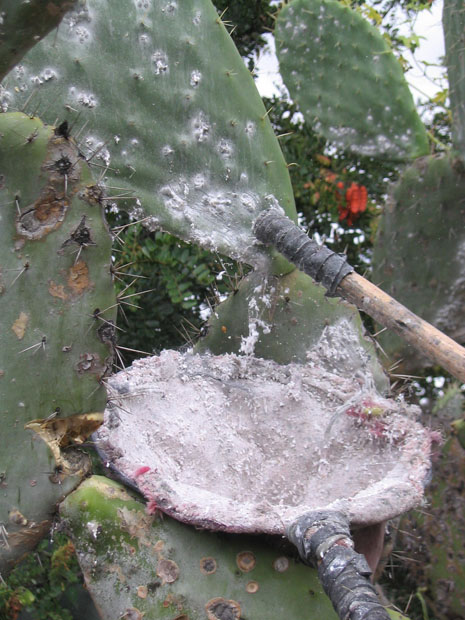
Photograph Copyright by Robin Smalley
Campesinos make trips to the city to sell their cochineal, at a frequency determined by quantity of the cochineal harvest, as well as by economic necessity. According to Sergio, while the family prefers to amass quantities of cochineal before selling, pressing economic need often prompts immediate sale. All members of the Perez family harvest cochineal. While Sergio devotes all of his daylight hours to collection during the peak of cochineal production, frequently wife and mother Felicitas directs the majority of cochineal harvest and commerce activities within the household, often traveling to nearby communities to buy and/or sell cochineal. These processes of buy and sell occur concurrently, as most campesinos informed me that they often buy cochineal from neighbors in order to accumulate more before selling to menoristas.
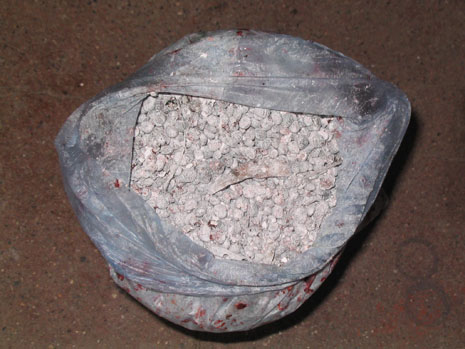
Photograph Copyright by Robin Smalley
Menoristas buy cochineal from campesinos through both regular purchase trips to communities, as well as through exchanges at vendor locales in urban Huamanga. Vendor Diana Toledo has sold cochineal from her parents' home in Huamanga for the past 16 years; prior to her selling, her parents bought and sold cochineal at this same locale for some twenty years. Though no sign hangs above the doorway advertising cochineal commerce within, the campesinos who have visited this family operation for the past thirty-five years know it from experience. Diana receives visits from farmers between the hours of 8 am-1pm daily, and maintains her post, with a scale and calculator at hand. Many vendors sell wool, leather and tara (a powder of the seeds of the Caesalpina spinosa tree), in addition to cochineal; though the international purchase price of cochineal has risen within the past years, menoristas contend that cochineal market is perilous and sell other goods to diversify.
After campesino and menorista negotiate the price, the vendor dries the fresh cochineal, usually through spreading the insects onto thin metal sheets on the rooftop. Depending on sunlight and temperature, cochineal requires around seven days to fully dry. During the rainy season, cochineal commerce slows dramatically, as precipitation affects the quality of insect harvested, as well as the opportunity to produce dry cochineal. While vendors examine the quality of the fresh cochineal prior to purchase, the main inspection occurs after amassing and drying between 20-30 kilograms. Following the drying stage, menoristas remove debris and immature insects from the cochineal, in order to prepare for further sale. The resale value of dried cochineal surpasses the purchase price of the fresh insect: 40 soles ($12.67) per kilo of versus 11 soles ($3.50 US dollars) per kilo, respectively, although it takes about 3 kilos of fresh cochineal to make a dry kilo.
Menoristas initially categorize cochineal into two groups: fresh and dry. These vendors then further classify dried cochineal into first, second and third-class qualities, each yielding a particular price. Insect size, condition, and purity determine cochineal prices within their respective classes. Menoristas sell their sorted cochineal to large-scale vendors, called mayoristas. Mayoristas, usually based in Lima, determine the buy and sell prices for cochineal around the country, in accordance with international supply and demand. Diana and her husband prefer to personally transport and sell their animal hides, tara and cochineal in Lima, because there they can negotiate higher prices, as well as work directly with a familiar mayorista, Diana's brother, who grinds the dyestuff into powdered form before exporting internationally.
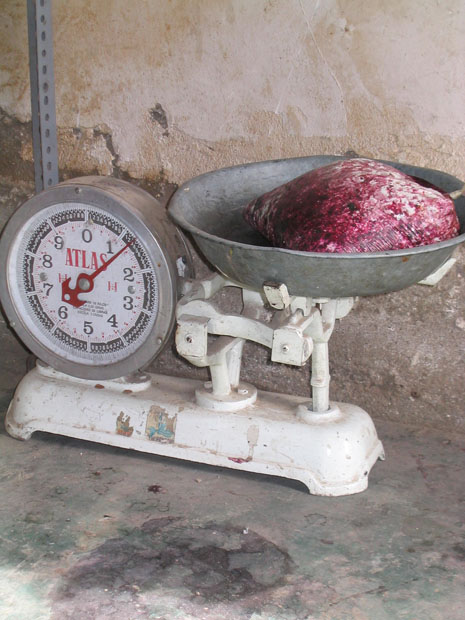
Photograph Copyright by Robin Smalley
Upon returning to Ayacucho in October 2007, I will continue to explore the cochineal exchange and plan to meet with several mayoristas, including Diana's brother. As I investigate each stage in the chain of cochineal cultivation, production and commercialization, I ultimately seek to understand the sequence and processes of events that lead to its use as a dyestuff. The campesinos, menoristas, mayoristas and artesanos (artisans) of Huamanga, Ayacucho, Peru ostensibly engage in dynamic relationships between ecology, economy, and craft that influence the international cochineal trade. While cochineal's reputation as a vibrant natural dye permeates fiber art circles worldwide, its actual context often is unknown. I encourage fellow natural dyers to consider the origins of their colors, like those of cochineal, in order to sustain their legacies through cultural awareness, fair procurement and intentional use.
Note: The names of all inviduals mentioned in the article, except for that of cochineal expert Victor Flores Flores, have been changed.
 Turkey Red Journal
Turkey Red Journal
